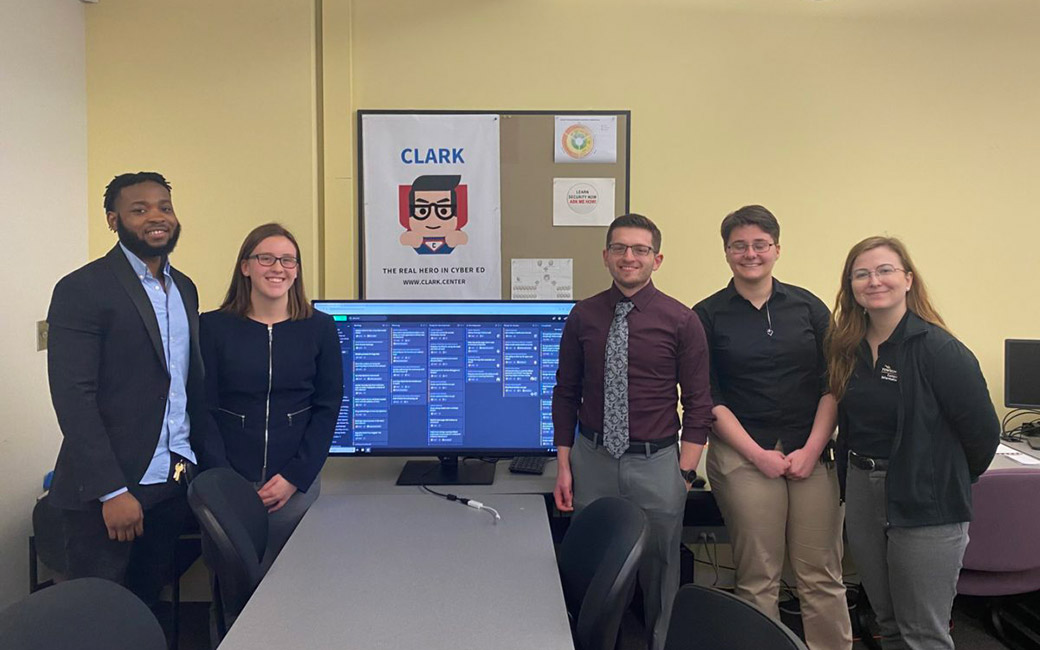In need of virtual lesson plans, educators turn to a resource run by TU students
Run by computer science students, cybersecurity education platform CLARK is expanding its content to better support distance learning
By Rebecca Kirkman on March 25, 2020

As educators around the world face the unexpected transition to distance learning in response to the COVID-19 outbreak, many are creating, developing and sharing virtual lesson plans.
Those teaching cybersecurity are in luck: more than 750 learning modules are available for free through the Cybersecurity Labs and Resource Knowledgebase (CLARK), an online platform created by Towson University with a grant from the NSA in 2017 and maintained by TU students.
A new collection of curriculum on CLARK, dubbed Plan C, aims to collect and organize new content being generated by faculty across the country, and get that needed content into the hands of educators as quickly as possible.
“We knew faculty like me would be trying to get their curriculum online, making recordings, and coming up with great material that we wanted to share to help everybody,” says Blair Taylor, a clinical professor in the Department of Computer & Information Sciences and co-director of the CLARK team.
“Our existing collections are stringently reviewed, but we launched Plan C to streamline that process because we wanted to get things out more quickly. We felt like faculty would be creating a lot of things during this time and we wanted to get it all in one place.”
CLARK builds upon Towson University’s long-standing preeminence in cybersecurity. TU is a National Center of Academic Excellence (CAE) in Cyber Defense Education and one of only 19 National CAEs in Cyber Operations.
Read more: TU faculty keep U.S. cybersecurity curricula safe (and organized)
Co-led by Professor Sidd Kaza, the team has more than a decade of experience developing and managing cybersecurity curriculum through initiatives like the Security Injections Project, embedding security into computing education, and Cyber4All, an interdisciplinary approach to cybersecurity.
The curriculum on the site was developed by 54 schools that were funded by NSA grants over 2.5 years. After going through an extensive review process, the CLARK team formalized the nomenclature to make it easy for faculty to use the materials in their classrooms. “It’s all cybersecurity related, from technical things like quantum cryptography to introduction to cybersecurity,” Taylor says.
Users from universities, community colleges, companies and K-12 schools across the country have downloaded nearly 3,000 modules since CLARK launched. While CLARK continues to accept lesson plans for the Plan C collection, its existing curriculum can also be filtered by topic, education level, and if it includes video.
Since mid-March, when many schools made the decision to suspend in-person classes, the number of visitors has spiked.
“We’ve seen a huge increase in the usage of our site,” says Paige Zaleppa ’19 ’21, a graduate student studying computer science and CLARK’s product manager. “We had 130 unique downloads in a day. That’s an all-time high.”
Normally working from the fourth floor of 7800 York Road, the team of undergraduate and graduate students runs like a software development shop. Each day at 11 a.m., the team holds a scrum meeting to go over the day’s work. With the team now working remotely, those meetings have continued virtually through Webex.
“We’re learning how to work together but apart,” Zaleppa says, noting the increased use of video meetings, chat programs and Google Docs. “The cool thing is that we’re all students. We’re going to be able to take this experience back to our group projects. We can say, ‘Hey this worked for our team, maybe this could work for our group.’ We’re all learning together, which is a really unique part of our team.”
Learning together alongside faculty is a valuable opportunity for students like Zaleppa.
“Everyone on our team talks about how much they have learned outside of the classroom. We jokingly call it ‘CLARK class.’ We’re learning new technology that is just coming out alongside our professors, and that’s not something we get to do in the classroom as much.”
Kaza is working with Taylor to diversify funding for the site. With increased support, it could expand to serve a broader range of education levels and employ more student developers.
“This has provided an educational opportunity, a learning opportunity, which has gone beyond what Blair and I ever imagined,” Kaza says.
This story is one of several related to President Kim Schatzel’s priorities for Towson University: TU Matters to Maryland.